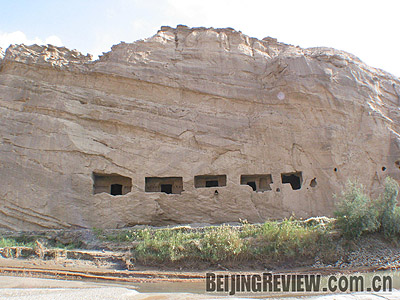| After eight years of hard work, the conservation and restoration project at the Kumtura Thousand Buddha Caves in China's Xinjiang Uygur Autonomous Region has finally been completed.

As one of the cultural heritage protection programs of the United Nations Educational, Scientific and Cultural Organization (UNESCO), the conservation project at the Kumtura Thousand Buddha Caves was funded by the Japanese Government and jointly implemented by the Chinese State Administration of Cultural Heritage (SACH) and the Xinjiang Bureau of Cultural Heritage.
At a seminar on the outcome of the project held in Beijing on February 21, Tong Mingkang, Deputy Minister of the SACH, said that the project has achieved remarkable progress since it was started in 2000, based on the joint efforts of experts from China, Japan and the UNESCO.
"Through mature conservation techniques, comprehensive restoration and the creation of conservation guidelines based on pilot conservation work, the project has greatly improved the condition of the heritage site," Tong said, adding that it has also advanced the development of similar conservation work in China.
Experts who attended the seminar also agree that the success of the Kumtura project is a classic example of cooperation between China and other countries in conserving cultural heritage, which has accumulated rich experience for future work in this field.
According to Huang Kezhong, a researcher at the Chinese Academy of Cultural Heritage, who also attended the seminar, the Kumtura Thousand Buddha Caves were built more than 1,000 years ago and face threats from human activities such as tourist visits and natural damage from weather, water infiltration and collapse because of cracks in the rock.
In 1998, China and Japan reached an agreement to protect the remaining ancient sites along the Silk Road, and the Kumtura grottoes were among the sites that would be restored. In the following year, an inspection team organized by UNESCO went to the Kumtura Thousand Buddha Caves to carry out an investigation. In April 2000, experts from China and Japan, together with representatives of UNESCO, worked out a plan and a schedule for the conservation operation. According to the plan, the Japanese Government would provide $1.25 million to aid the conservation work, one part of the UNESCO Funds-in-Trust Project. The Chinese Government also provided funds to fulfill this project.
According to UNESCO China's official website, the whole conservation project is comprised of two phases. Phase I, which was done during 2001-2005, mainly included the collection of data such as geological surveying, aerial mapping, atmospheric testing and initial conservation testing. Based on the findings of Phase I, full-scale conservation was carried out during Phase II between 2005-2008, including concrete testing at two selected pilot areas.
Because of the danger facing the caves, such as rock cracks or collapse, flaking frescos, flood erosion and rot, most caves were reinforced to ensure their safe maintenance in the future.
It was also announced at the seminar in Beijing that experts from the two countries would carry out long-term conservation and maintenance in the caves, in order to standardize the regular protection work and keep this heritage for future generations.
New concept
Another important result of the painstaking efforts of experts from the two countries is the new concept developed in the conservation of this cultural heritage site.
Wubuli Maimaitiaili, Director of the Division of Conservation of Cultural Relics of the Xinjiang Bureau of Cultural Heritage, who participated in the conservation work, said in an article in the Beijing-based Guangming Daily that the project not only attracted financial support, but also provided an ideal opportunity for experts to have a deeper understanding about the conservation of such kind of cultural relics.
"In the past, when we saw a damaged cultural heritage, we were anxious to engage in a lot of restoration work, lacking enough patience to find out the true causes of the damage," he said, adding that providing extra funding for restoration work is worthless without finding out the root problems of the damage.
According to him, looking back at the conservation project of the Kumtura Thousand Buddha Caves, the majority of the time and funds were spent on collecting of related data. "Experts from both countries set up a weather station, analyzing all the data for eight years, in order to find the laws of the natural effect to the caves," he said.
Taking fresco protection as an example, he said that experts collected relevant data, such as the temperature and light in the caves, using advanced equipment, analyzed the composition of the paint and painting technique of the frescos, and then worked out an overall protection plan for the frescos in the caves.
He also explained the importance of data collection, saying that this gave them confidence when applying for the world cultural heritage status to the UNESCO.
| 